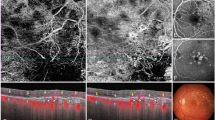Abstract
Purpose
To study the correspondence between fluorescein angiography (FA) and structural en face optical coherence tomography (OCT) in the identification of leaky microaneurysms in diabetic macular edema (DME).
Methods
Fourteen eyes of eight patients with DME (6 males and 2 females, mean age 67.3 ± 8.5) were included. For all eyes, a 6 × 6 mm structural en face image of the middle retina was obtained and superimposed on a FA image. The reflectivity, capsulation, and association with intraretinal cystic fluid (IRCF) of microaneurysms on en face were evaluated depending on their leaky status on FA.
Results
Out of the 320 leaky microaneurysms evaluated, 280 (89.0 ± 8.2%) coincided with those on en face OCT image. Twenty-nine (10.6 ± 6.9%) and 20 (6.5 ± 7.8%) out of all leaky microaneurysms were hyperreflective and demonstrated capsular appearance, respectively. A majority of leaky microaneurysms (97.9 ± 3.2%) were associated with IRCF. From 146 microaneurysms which were found only on en face images, 130 (88.2% ± 15.7%) were hyperreflective, 33 (23.9% ± 15.6%) demonstrated capsular structure, and 13 (9.2% ± 15.0%) demonstrated no associated IRCF. After exclusion of microaneurysms of the inner retina, 95.4 ± 5.4% of leaky microaneurysms were identified on en face image. En face imaging demonstrated 83.5% sensitivity and 89.4% specificity (the area under the curve 0.87) in the identification of leaky microaneurysms.
Conclusions
Structural en face imaging is comparable to FA in identification of leaky microaneurysms in diabetic macular edema. Moderate reflectivity, the absence of capsular structure, and neighboring intraretinal cystic fluid indicate leaky microaneurysms.



Similar content being viewed by others
References
Early Treatment Diabetic Retinopathy Study Research Group (1995) Focal photocoagulation treatment of diabetic macular edema. Relationship of treatment effect to fluorescein angiographic and other retinal characteristics at baseline: ETDRS report no. 19. Arch Ophthalmol 113(9):1144–1155
Aiello LP, Edwards AR, Beck RW, Diabetic Retinopathy Clinical Research Network et al (2010) Factors associated with improvement and worsening of visual acuity 2 years after focal/grid photocoagulation for diabetic macular edema. Ophthalmology 117(5):946–953
Lee SN, Chhablani J, Chan CK et al (2013) Characterization of microaneurysm closure after focal laser photocoagulation in diabetic macular edema. Am J Ophthalmol 155(5):905–912
Brown DM, Schmidt-Erfurth U, Do DV et al (2015) Intravitreal Aflibercept for Diabetic Macular Edema: 100-week results from the VISTA and VIVID studies. Ophthalmology 122(10):2044–2052
Boiko EV, Maltsev DS (2017) Combination of navigated macular laser photocoagulation and anti-VEGF therapy: precise treatment for macular edema under dry retinal conditions. J Ophthalmol 2017:7656418
Maltsev DS, Kulikov AN, Uplanchiwar B et al (2018) Direct navigated laser photocoagulation as primary treatment for retinal arterial macroaneurysms. Int J Retina Vitr 4:28
Kozak I, Oster SF, Cortes MA et al (2011) Clinical evaluation and treatment accuracy in diabetic macular edema using navigated laser photocoagulator NAVILAS. Ophthalmology 118(6):1119–1124
Early Treatment Diabetic Retinopathy Study Research Group (1991) Classification of diabetic retinopathy from fluorescein angiograms. ETDRS report number 11. Ophthalmology 98(5 Suppl):807–822
Yannuzzi LA, Rohrer KT, Tindel L et al (1986) Fluorescein angiography complication survey. Ophthalmology 93(5):611–617
Kwiterovich KA, Maguire MG, Murphy RP et al (1991) Frequency of adverse systemic reactions after fluorescein angiography. Results of a prospective study. Ophthalmology 98(7):1139–1142
Nagiel A, Sadda SR, Sarraf D (2015) A promising future for optical coherence tomography angiography. JAMA Ophthalmol 133(6):629–630
Schreur V, Domanian A, Liefers B et al (2019) Morphological and topographical appearance of microaneurysms on optical coherence tomography angiography. Br J Ophthalmol 103:630–635
Spaide RF, Klancnik JM Jr, Cooney MJ (2015) Retinal vascular layers imaged by fluorescein angiography and optical coherence tomography angiography. JAMA Ophthalmol 133(1):45–50
Wang H, Chhablani J, Freeman WR et al (2012) Characterization of diabetic microaneurysms by simultaneous fluorescein angiography and spectral-domain optical coherence tomography. Am J Ophthalmol 153(5):861–867
Ito H, Horii T, Nishijima K et al (2013) Association between fluorescein leakage and optical coherence tomographic characteristics of microaneurysms in diabetic retinopathy. Retina 33(4):732–739
Hasegawa N, Nozaki M, Takase N et al (2016) New insights into microaneurysms in the deep capillary plexus detected by optical coherence tomography angiography in diabetic macular edema. Investig Ophthalmol Vis Sci 57(9):348–355
Soliman W, Sander B, Hasler PW, Larsen M (2008) Correlation between intraretinal changes in diabetic macular oedema seen in fluorescein angiography and optical coherence tomography. Acta Ophthalmol 86(1):34–39
Reznicek L, Kernt M, Haritoglou C et al (2011) Correlation of leaking microaneurysms with retinal thickening in diabetic retinopathy. Int J Ophthalmol 4(3):269–271
Blair NP, Shahidi M, Lai WW, Zelkha R (2008) Correlation between microaneurysms and retinal thickness in diabetic macular edema. Retina 28(8):1097–1103
Funding
The authors have not received any grant support for this study. The authors have no proprietary or financial interest in any aspect of this report.
Author information
Authors and Affiliations
Corresponding author
Ethics declarations
Conflict of interest
The authors declare that they have no conflict of interest.
Ethical approval
All procedures performed in studies involving human participants were in accordance with the ethical standards of the institutional and/or national research committee and with the 1964 Declaration of Helsinki and its later amendments or comparable ethical standards.
Informed consent
Informed consent was obtained from all individual participants included in the study.
Additional information
Publisher's Note
Springer Nature remains neutral with regard to jurisdictional claims in published maps and institutional affiliations.
Rights and permissions
About this article
Cite this article
Maltsev, D.S., Kulikov, A.N., Burnasheva, M.A. et al. Structural en face optical coherence tomography imaging for identification of leaky microaneurysms in diabetic macular edema. Int Ophthalmol 40, 787–794 (2020). https://doi.org/10.1007/s10792-019-01239-w
Received:
Accepted:
Published:
Issue Date:
DOI: https://doi.org/10.1007/s10792-019-01239-w




